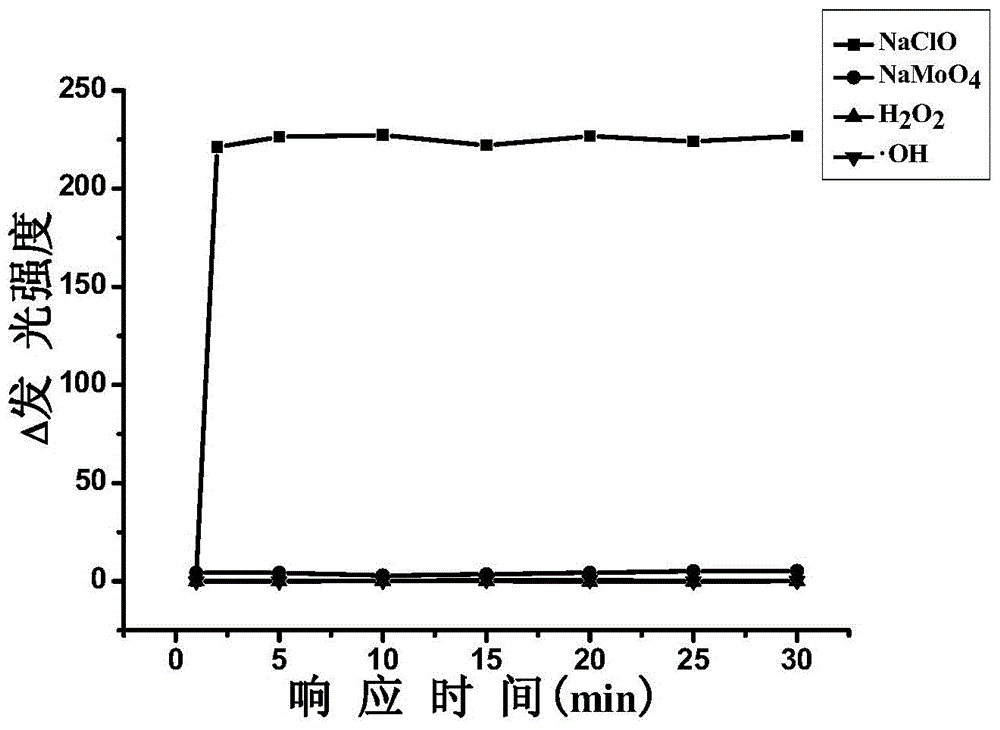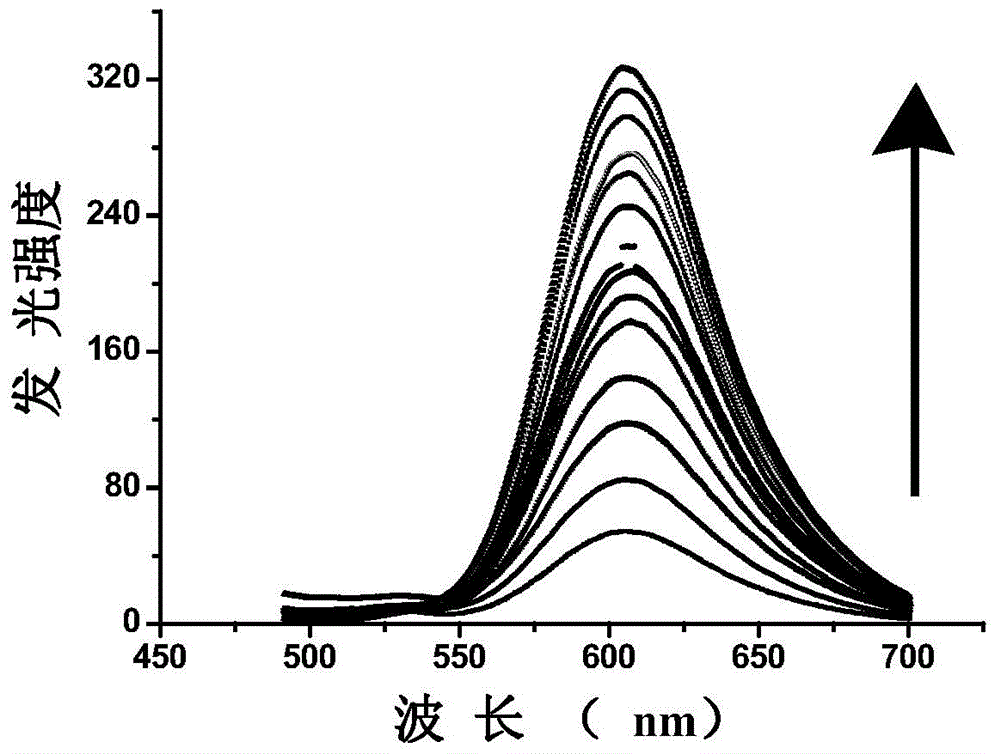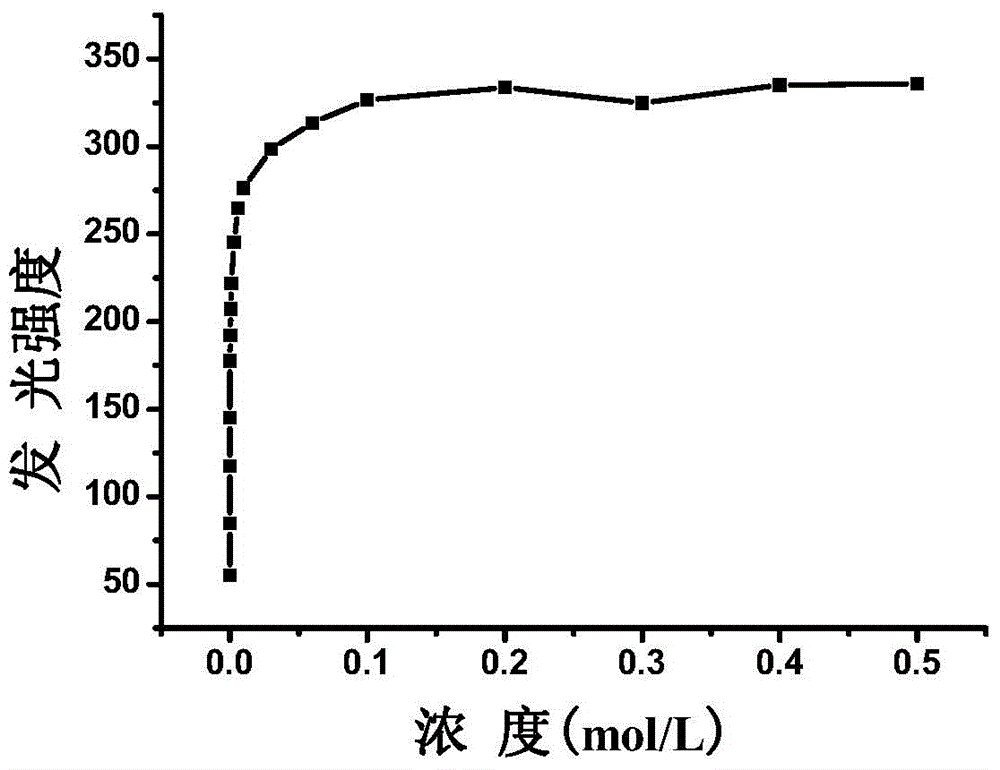Method for reversible detection on hypochlorite and hydrogen sulfide
A technology of hypochlorite and hydrogen sulfide, applied in the direction of material excitation analysis, fluorescence/phosphorescence, etc., can solve the problems of poor redox stability, inability to achieve reversible, cyclic detection, etc., and achieve the effect of reversible detection
- Summary
- Abstract
- Description
- Claims
- Application Information
AI Technical Summary
Problems solved by technology
Method used
Image
Examples
Embodiment 1
[0086] Using the LS55 type fluorescence detector, select the concentration of Ru-PTZ luminescent probe molecule as 1×10 -5 mol / L, the excitation light wavelength is set to 450nm, the scanning wavelength range is 470nm-700nm, and the buffer solution used is 0.1mol / L phosphate buffer solution with pH=7.4. Add the same concentration (1×10 -4 mol / L) different types of active oxygen species (the active oxygen species added are: sodium hypochlorite, sodium molybdate, H 2 o 2 , · OH), to investigate the response of the probe to different reactive oxygen species. From figure 1 It can be seen that compared with other active oxygen species, the probe has a specific, highly sensitive response to sodium hypochlorite, and the response is very rapid.
Embodiment 2
[0088] Using the LS55 type fluorescence detector, select the concentration of Ru-PTZ luminescent probe molecule as 1×10 -5 mol / L, the excitation light wavelength is set to 450nm, the scanning wavelength range is 470nm-700nm, and the buffer solution used is 0.1mol / L phosphate buffer solution with pH=7.4. Different concentrations of sodium hypochlorite were added to the detection system to observe its effect on the luminescence intensity of the probe. pass figure 2 It can be observed that after sodium hypochlorite is added to the detection system, the luminescence intensity of the probe increases uniformly with the concentration of sodium hypochlorite, while the binding image 3 It can be seen that when the concentration of sodium hypochlorite reaches 1×10 -4 mol / L, the luminescence intensity of the probe increases to reach saturation, after which the luminescence intensity of the probe no longer changes with the increase of the concentration of sodium hypochlorite. accordin...
Embodiment 3
[0090] Using the LS55 type fluorescence detector, select the concentration of Ru-PTZ luminescent probe as 1×10 -5 mol / L, the excitation light wavelength is set to 450nm, the scanning wavelength range is 470nm-700nm, and the buffer solution used is 0.1mol / L phosphate buffer solution with pH=7.4. Add different species to the detection system, 1×10 -4 mol / L of interfering ions or substances, and then add 1×10 -4 mol / L sodium hypochlorite, to investigate whether the added interfering ions or substances will affect the detection, so as to investigate the selectivity of the probe to sodium hypochlorite. according to Figure 5 It can be seen that the response of the probe to the added interfering ions or substances is weak, but it has a strong response to sodium hypochlorite. Therefore, even in the presence of the above-mentioned interfering components or substances, the probe will still produce a specific and highly sensitive response to sodium hypochlorite.
PUM
 Login to View More
Login to View More Abstract
Description
Claims
Application Information
 Login to View More
Login to View More - R&D
- Intellectual Property
- Life Sciences
- Materials
- Tech Scout
- Unparalleled Data Quality
- Higher Quality Content
- 60% Fewer Hallucinations
Browse by: Latest US Patents, China's latest patents, Technical Efficacy Thesaurus, Application Domain, Technology Topic, Popular Technical Reports.
© 2025 PatSnap. All rights reserved.Legal|Privacy policy|Modern Slavery Act Transparency Statement|Sitemap|About US| Contact US: help@patsnap.com



